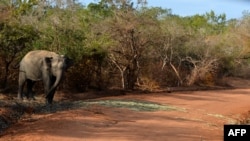Tucked inside a large forest near the drying Andaraweva iirrigation reservoir, a well-tended plantation of young banana trees is growing strongly despite dry weather.
The plantation, of at least 10 acres, is unauthorized but has been growing for two years, say wildlife rangers policing the forest.
"They just come in, clear the jungle and plant whatever they want. There is absolutely nothing that anybody can do," said Ajith Gunathunga, head of the Hambantota wildlife office.
Illegal plantings in forest areas are on the rise in drought-hit southern Sri Lanka, where farmers struggling with water shortages worsened by climate change are looking for any way to get a crop.
Jayalath, who lives in a village near the banana plantation and who would not give his surname, fearing legal action, said he and other residents had together planted the bananas, as water for other crops outside the forest ran low.
Asked permission
"We sought government permission to use the water from the tank nearby as a farmer collective and got permission," he said.
The group did not mention to the village official who gave permission to use the water that it was for the banana plantation, Jayalath said.
The official, who did not want to give his name, confirmed he had verbally approved the group's use of water from the tank. Wildlife rangers say they cannot act to remove illegal crops in forest land, because that action needs to be taken by the Forestry Department.
But forestry officers say that since the farmers' collective has received some type of official authorization to use water in the forest, taking action against the plantation would be difficult.
The banana plantation is fed from a water storage tank — intended for animals — located about a kilometer away. The water, sucked up by five industrial water pumps powered by small tractor engines, flows in channels to the field.
But the heavy use of water for the plantation is now leaving others — including elephants, deer and other wild animals in the area — with less water available, said Gunathunga of the wildlife service.
"The problem is there is overuse of water and the animals now find it hard to survive. The unpredictability of the rains makes this competition for water very serious," he said.
Unreliable rain
Rains are becoming increasing erratic in the region. In May this year, heavy rain fell, but then was followed by four arid months where temperatures consistently hit 40 degrees Celsius, according to the Meteorological Department.
In the past, temperatures would have been lower, with the summer months interrupted by rain.
"The impact of climate change is here and clear. What we need now are measures to adjust to those changes," said W.H. Karunarathne, the Hambantota District secretary, the top government official in the district.
Such measures should include more monitoring of water use and planting of crops that require less water, he said.
He admitted that it was difficult to take action against farmers who are struggling with a lack of water. But the top government official in the district added that farmers and state officials were devising new means to adapt to varying water availability.
"The crux of the problem is that water availability does not follow traditional patterns now, and people don't know what to do," he said.
This year, when the rice harvest was completed in May, Karunarathne's office urged farmers to plant crops that need little water in their fields before planting paddy rice again the following season.
That is a change from the traditional practice of leaving dried-out rice paddies unused until the next rains.
Government seed
Over 4,000 acres were planted with government-provided green gram seed — also known as mung beans — this year. Though the experiment was not wholly
successful, some farmers were able to earn the equivalent of 80 cents per kilo for the additional crop.
A number of farmers resisted the effort, Karunarathne said, but he believes fewer farmers will be skeptical next year after seeing the harvest.
In another case this summer, Karunarathne used weather information provided by the Meteorological Department to authorize the release of water stored for rice production to rescue dry banana plantations, after the farmers sought his
help. Such releases remain rare in Sri Lanka.
"I had a look at the weather updates and released water based on that despite protests by traditional paddy farmers in the region," Karunaratne said. In the end, "we saved the bananas as well as the paddy."
Wildlife official Gunathunga believes more such coordinated action is needed.
"We are all on the same page here: the farmers, the animals and the officials. We need to work together," he said.











